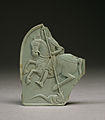Soapstone

Soapstone (also known as steatite or soaprock) is a talc-schist, which is a type of metamorphic rock. It is composed largely of the magnesium-rich mineral talc. It is produced by dynamothermal metamorphism and metasomatism, which occur in subduction zones, changing rocks by heat and pressure, with influx of fluids but without melting. It has been a carving medium for thousands of years.
Terminology
The definitions of the terms "steatite" and "soapstone" vary with the field of study. In geology, steatite is a rock that is, to a very large extent, composed of talc. The mining industry defines steatite as a high-purity talc rock that is suitable for the manufacturing of, for example, insulators; the lesser grades of the mineral can be called simply "talc rock". Steatite can be used both in lumps ("block steatite", "lava steatite", "lava grade talc"), and in the ground form. While the geologists logically will use "steatite" to designate both forms, in the industry, "steatite" without additional qualifications typically means the steatite that is either already ground or to be used in the ground form in the future. If the ground steatite is pressed together into blocks, these are called "synthetic block steatite", "artificial block steatite", or "artificial lava talc".[1]
In industrial applications soapstone refers to dimension stone that consists of either amphibole-chlorite-carbonate-talc rock, talc-carbonate rock, or simply talc rock and is sold in the form of sawn slabs. "Ground soapstone" sometimes designates the ground waste product of the slab manufacturing.[1]
Petrology

Petrologically, soapstone is composed predominantly of talc, with varying amounts of chlorite and amphiboles (typically tremolite, anthophyllite, and cummingtonite, hence its obsolete name, magnesiocummingtonite), and traces of minor iron-chromium oxides. It may be schistose or massive. Soapstone is formed by the metamorphism of ultramafic protoliths (e.g. dunite or serpentinite) and the metasomatism of siliceous dolomites.
By mass, "pure" steatite is roughly 63.37%
Pyrophyllite, a mineral very similar to talc, is sometimes called soapstone in the generic sense, since its physical characteristics and industrial uses are similar,[3] and because it is also commonly used as a carving material. However, this mineral typically does not have such a soapy feel as soapstone.
Physical characteristics
Soapstone is relatively soft because of its high talc content—talc has a definitional value of 1 on the
Soapstone is easy to carve; it is also durable and heat-resistant and has a high heat storage capacity. It has therefore been used for cooking and heating equipment for thousands of years.[4]
Soapstone is often used as an
Historical usage
Africa
Ancient Egyptian
Americas
Indigenous peoples of the Arctic have traditionally used soapstone for carvings of both practical objects and art. The qulliq, a type of oil lamp, is carved out of soapstone and used by the Inuit, Chukchi, and Yupik peoples. This kind of lamp was the single most important article of furniture for the Inuit in their dwellings.
In the modern period, soapstone is commonly used for carvings in Inuit art.[10]
In the United States, locally quarried soapstone was used for gravemarkers in 19th century northeast Georgia, around Dahlonega, and Cleveland as simple field stone and "slot and tab" tombs. Small blocks of soapstone (8" x 10" x 1") were also heated on the cookstove or near the fire and used to warm cold bedclothes or to keep hands and feet cozy while sleighing.
Asia

The ancient trading city of Tepe Yahya in southeastern Iran was a center for the production and distribution of soapstone in the 5th to 3rd millennia BC.[11]
Soapstone has been used in India as a medium for sculptures since at least the time of the
In China, during the
Soapstone was used as a writing pencil in Myanmar as early as the 11th-century Pagan period. After that, it was still used as a pencil to write on Black Parabaik until the end of the Mandalay period (19th century).
Australia
Pipes and decorative carvings of local animals were made out of soapstone by
Europe
The Minoan civilization on Crete used soapstone. At the Palace of Knossos, a steatite libation table was found.[17] Soapstone is relatively abundant in northern Europe. Vikings hewed soapstone directly from the stone face, shaped it into cooking pots, and sold these at home and abroad.[18] In Shetland, there is evidence that these vessels were used for processing marine and dairy fats.[19] Several surviving medieval buildings in northern Europe are constructed with soapstone, amongst them Nidaros Cathedral.[4]
Modern usage

In modern times, soapstone is most commonly used for architectural applications, such as counter tops, floor tiles, showerbases, and interior surfacing.
Soapstone is sometimes used for construction of fireplace surrounds, cladding on
Soapstone can be used to create molds for
. The soft stone is easily carved and is not degraded by heating. The slick surface of soapstone allows the finished object to be easily removed.Resistance to heat made steatite suitable for manufacturing gas burner tips, spark plugs, and electrical switchboards.[6]
Ceramics
Steatite ceramics are low-cost biaxial porcelains of nominal composition (MgO)3(SiO2)4.[22] Steatite is used primarily for its dielectric and thermally-insulating properties in applications such as tile, substrates, washers, bushings, beads, and pigments.[23] It is also used for high-voltage insulators, which have to stand large mechanical loads, such as insulators of mast radiators.
Crafts
Soapstone continues to be used for carvings and sculptures by artists and indigenous peoples. In Brazil, especially in the state of Minas Gerais, the abundance of soapstone mines allow local artisans to craft pots, pans, wine glasses, statues, jewel boxes, coasters, and vases from soapstone. These handicrafts are commonly sold in street markets found in cities across the state. Some of the oldest towns, notably Congonhas, Tiradentes, and Ouro Preto, still have some of their streets paved with soapstone from colonial times.
Mining
Architectural soapstone is mined in Canada, Brazil, India, and Finland and imported into the United States.[24] Active North American mines include one south of Quebec City with products marketed by Canadian Soapstone, the Treasure and Regal mines in Beaverhead County, Montana mined by the Barretts Minerals Company, and another in central Virginia operated by the Alberene Soapstone Company.
Mining to meet worldwide demand for soapstone is threatening the habitat of India's tigers.[25]
Other
Soapstones can be put in a freezer and later used in place of ice cubes to chill alcoholic beverages without diluting. Sometimes called whiskey stones, these were first introduced around 2007.[26] Most whiskey stones feature a semipolished finish, retaining the soft look of natural soapstone, while others are highly polished.
Safety
People can be exposed to soapstone dust in the workplace via inhalation and skin or eye contact. Exposure above safe limits can lead to symptoms including
United States
The
Other names
The local names for the soapstone vary: in Vermont, "grit" is used, in Georgia "white-grinding" and "dark-grinding" varieties are distinguished, and California has "soft", "hard", and "blue" talc.[29] Also:
- Combarbalite stone, exclusively mined in Combarbalá, Chile, is known for its many colors. While they are not visible during mining, they appear after refining.
- Palewa and gorara stones are types of Indian soapstone.
- A variety of other regional and marketing names for soapstone are used.[30]
Gallery
-
A 12th-century Byzantine relief of Saint George and the Dragon
-
Soapstone slot-and-tab tomb in Dahlonega, Georgia
-
An Egyptian carved and glazed steatite scarab amulet
-
Steatite scarab atthe Walters Art Museum
-
Nidaros Cathedral in Trondheim, Norway, constructed mainly of soapstone
See also
- List of minerals
- List of rocks
- Talc carbonate
- Archeological Site 38CK1, Archeological Site 38CK44, and Archeological Site 38CK45
References
- ^ a b Chidester, Engel & Wright 1963, p. 8.
- ISBN 0962209716.
- ISBN 9788290273908. Retrieved 26 November 2018.
- ^ ISBN 978-82-90273-90-8.)
{{cite book}}: CS1 maint: location missing publisher (link - ^ "Some Important Aspects of the Harappan Technological Tradition," Bhan KK, Vidale M and Kenoyer JM, in Indian Archaeology in Retrospect/edited by S. Settar and Ravi Korisettar, Manohar Press, New Delhi, 2002.
- ^ a b Hall, A. L. (1927). "On the talc deposits near Kaapmuiden, in the Eastern Transvaal". Transactions of the Geological Society of South Africa. 30: 83.
- ISBN 0500231389.
- ISBN 978-0-8173-0670-0.
- ^ Witthoft, J.G. (1949). "Stone pipes of the historic Cherokees". Southern Indian Studies. 1 (2): 43–62.
- ISBN 978-1-136-78680-8.
- ^ "Tepe Yahya," Encyclopædia Britannica, 2004. Britannica Concise Encyclopedia. 3 January 2004, Britannica.com
- ^ UGC NET History Paper II Chapter Wise Notebook | Complete Preparation Guide. EduGorilla. 1 September 2022. p. 485. Retrieved 26 October 2022.
- ISBN 978-81-7141-865-7.
- ^ a b "Soapstone sculptures". hoysala.in. 2008. Archived from the original on 15 February 2009. Retrieved 26 November 2018.
- ^ "Steatite Knife" at the Bath Museum of East Asian Art
- ^ Kelham, Megg (November 2010). "A museum in Finke: An Aputula Heritage project" (PDF). Territory Stories. pp. 1–97. Archived from the original (PDF) on 2019-05-10. Retrieved 11 May 2019.
- ^ C.Michael Hogan (2007) "Knossos Fieldnotes", The Modern Antiquarian
- ^ Else Rosendahl, The Vikings, The Penguin Press, 1987, page 105
- ^ Steele, Val. "Report on the analysis of residues from steatite and ceramic vessels from the site of Belmont, Shetland" (PDF). Shetland Amenity.
- ^ a b Weideman, Paul (2017-11-05). "There's a stove for every taste". The Santa Fe New Mexican. Retrieved 2017-12-14.
- ^ a b Damrosch, Barbara (2017-01-19). "The enduring appeal of wood stoves". The Washington Post. Retrieved 2017-12-14.
- ^ "Royalty Minerals". royaltyminerals.in. Retrieved 26 November 2018.
- ^ "Superior Technical Ceramics". Retrieved 26 November 2018.
- ^ "Soapstone gives countertops, tiles a look that's both new and old". The Washington Post. 2013-05-30. Retrieved 2014-01-11.
- ^ Barnett, Antony (2003-06-22). "West's love of talc threatens India's tigers". The Guardian. London. Retrieved 2007-01-09.
- ^ "Interview with the Inventor of Whisky Stones, Andrew Hellman". Whisky Stones. Retrieved 2021-06-08.
- ISBN 978-0-471-26883-3.
- ^ "CDC - NIOSH Pocket Guide to Chemical Hazards - Soapstone (containing less than 1% quartz)". www.cdc.gov. Retrieved 2015-11-21.
- ^ Chidester, Engel & Wright 1963, pp. 8–9.
- ^ "CST Personal Home Pages". cst.cmich.edu. Retrieved 26 November 2018.
Sources
- Chidester, Alfred Herman; Engel, Albert Edward John; Wright, Lauren Albert (1963). Talc resources of the United States (PDF). Washington: U.S. Govt. Print. Off.
Further reading
- Felce, Robert (2011) Soaprock Coast... The origins of English porcelain ISBN 978-0-956-9895-0-5
External links
- Soapstone Calculated Refractory Data w/ Technical Properties Converter (Incl. Soapstone Volume vs. Weight measuring units)
- Ancient soapstone bowl (The Central States Archaeological Journal)
- Soapstone Native American quarries, Maryland (Geological Society of America)
- Prehistoric soapstone use in northeastern Maryland (Antiquity Journal)
- The Blue Rock Soapstone Quarry, Yancey County, NC (North Carolina Office of State Archaeology)
- CDC - NIOSH Pocket Guide to Chemical Hazards
- Steatite historical marker in Decatur, Georgia


![Soapstone sculpture on the Hoysala temple at Belur, India[14]](http://upload.wikimedia.org/wikipedia/commons/thumb/f/fa/Belur2_retouched.jpg/120px-Belur2_retouched.jpg)




